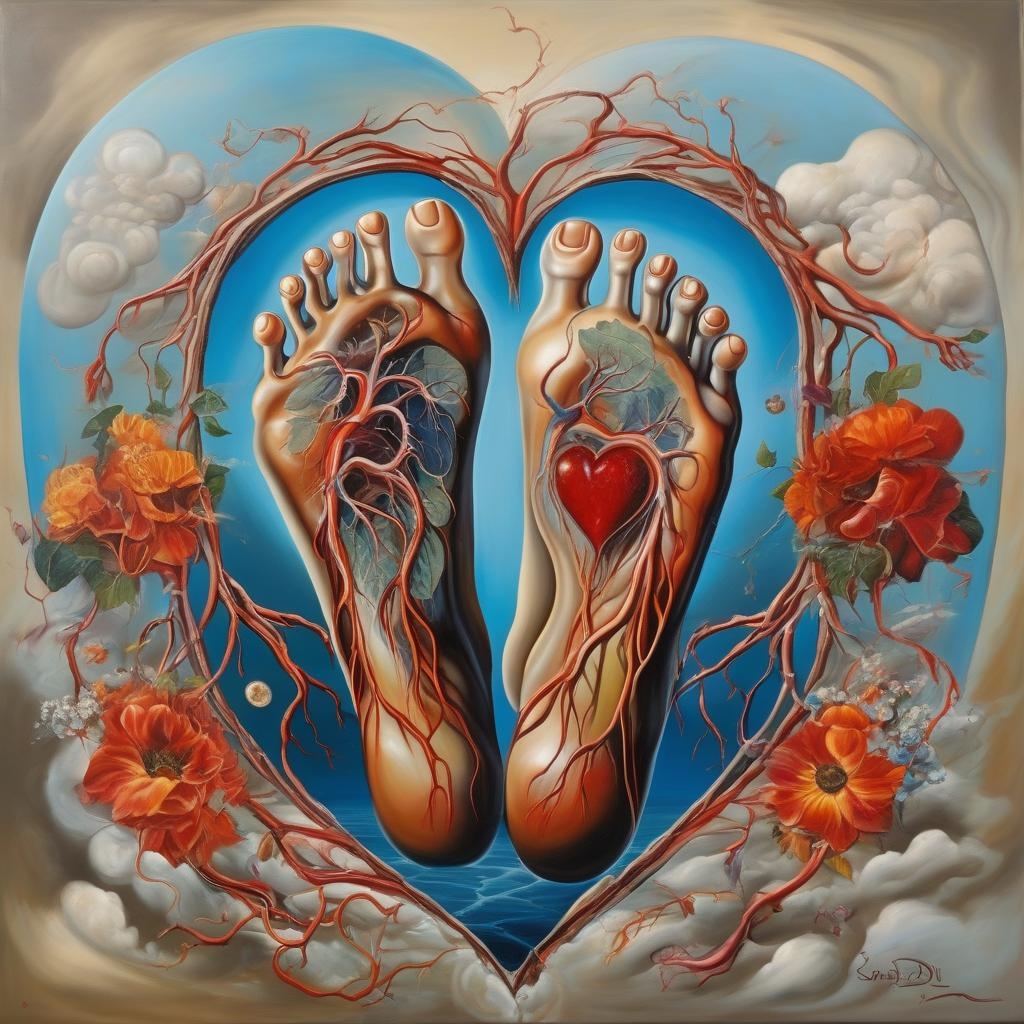「足は第二の心臓」と言われる背景には、足が全身の血液循環において非常に重要な役割を果たしているという考えがあります。この表現は特に以下の理由から生まれたものです:
1. **血液循環の補助**: 足の筋肉、特にふくらはぎの筋肉は、血液を心臓に押し戻す役割を果たすため、「筋肉ポンプ」とも呼ばれます。歩行やランニングなどの動作によって、ふくらはぎの筋肉が収縮し、足から心臓へと血液を送り戻すのに貢献します。
2. **静脈の弁**: 足の静脈には弁があり、血液が逆流しないようにしています。このメカニズムもまた心臓に似た働きをしており、全身の効率的な血流をサポートします。
3. **健康維持への影響**: 足のコンディションが悪いと、血行不良が起こりやすくなり、全身に影響を与えるため、健康維持の観点からも重要とされています。
つまり、「足は第二の心臓」という表現は、足が全身の健康や血液循環において不可欠な役割を果たしていることを強調するために使われます。定期的な運動やマッサージなどは、これらの機能を助け、健康を保つために重要とされています。
足の健康を維持し、効果的に血液循環を促進するための運動はいくつかあります。以下は、特に効果的な足の運動方法です:
1. **ウォーキング**: 毎日適度な速度でのウォーキングは、ふくらはぎの筋肉を鍛え、血液循環を促進するシンプルで効果的な運動です。
2. **カーフレイズ(かとの上げ下げ運動)**:
– 立った状態で、ゆっくりとかかとを上げてつま先立ちになり、その後かとを元の位置に戻します。
– これを数回繰り返します。ふくらはぎの筋肉を強化し、血流を改善します。
3. **足首のストレッチ**:
– 座った状態で足を前に伸ばし、つま先を上下に動かします。
– 足首を回すことも血流を良くし、関節の柔軟性を高めます。
4. **スクワット**:
– スクワットは太もやふくらはぎの筋肉を強化するために非常に効果的です。
– 足を肩幅に開き、膝を曲げながら腰を下げ、また元に戻します。
5. **手押しポンプ**:
– 座った状態で、交互に足の指を握ったり開いたりします。
– これにより、足全体の血流が促進されます。
6. **タオル引き運動**:
– 座って足元にタオルを置き、つま先でタオルを手繰り寄せる運動。
– これで足の裏の筋肉を鍛えられます。
これらの運動は、無理のない範囲で行うことが大切です。また、長時間座っているときには適度に立ち上がったり歩いたりすることも、血行促進に役立ちます。定期的な運動が習慣化されると、足はもちろん全身の健康維持にもつながります。
障害をお持ちの方や車椅子生活をしている方でも、足の健康を維持し、血液循環を促進する運動は可能です。以下は、安全に行える効果的な運動の一例です:
1. **足首回し**:
– 車椅子に座った状態で、足を軽く持ち上げ、足首をゆっくりと円を描くように回します。
– 左右両方の方向に回すことで、足首の柔軟性を高め、血流を促します。
2. **ふくらはぎのストレッチ**:
– 足の指を前方に伸ばし、その後元に戻す動作を繰り返します。
– この動きは血液循環を改善し、下肢の筋肉を刺激します。
3. **つま先押し**:
– 足をまっすぐにして、つま先を地面に向かって押し出すように動かし、その後、引き戻します。
– これはふくらはぎの筋肉を活性化し、むくみの軽減に役立ちます。
4. **膝の屈伸運動**:
– 車椅子や座った状態で膝を軽く曲げ、戻す動作を繰り返し行います。
– 可能であれば、軽く足を持ち上げることも役立ちます。
5. **足裏のマッサージ**:
– 足を手で軽く押したり、もんだりして血行を促進します。
– 簡単なテニスボールや専用の足裏ローラーを使用してマッサージすることも効果的です。
これらの運動は、車椅子や座った状態で安全に行うことができますが、実施にあたっては医療専門家のアドバイスを受けることが重要です。各種障害の状態に応じた運動をすることで、足の健康を維持し、生活の質を向上させることが可能です。

Here’s the translation of the provided text into natural level English:
—
The phrase “the foot is the second heart” stems from the idea that the feet play a crucial role in blood circulation throughout the body. This expression has arisen particularly for the following reasons:
1. **Aid in Blood Circulation**: The muscles in the feet, especially the calf muscles, function to push blood back to the heart, which is why they are also known as the “muscle pump.” Movements such as walking and running cause the calf muscles to contract, helping return blood from the feet to the heart.
2. **Vein Valves**: The veins in the feet contain valves that prevent blood from flowing backward. This mechanism resembles that of the heart, supporting efficient blood flow throughout the body.
3. **Impact on Health Maintenance**: Poor foot condition can easily lead to poor circulation, affecting the entire body, thus highlighting the importance of foot health in maintaining general well-being.
Thus, the phrase “the foot is the second heart” is used to emphasize the essential role of the feet in overall health and blood circulation. Regular exercise and massage are important for supporting these functions and maintaining health.
To maintain foot health and effectively promote blood circulation, there are several beneficial exercises:
1. **Walking**: Daily walking at a moderate pace is a simple and effective exercise that strengthens the calf muscles and promotes blood circulation.
2. **Calf Raises**:
– Stand and slowly lift your heels to rise onto your toes, then return to the starting position.
– Repeat several times. This strengthens the calf muscles and improves blood flow.
3. **Ankle Stretching**:
– While seated, extend your legs and move your toes up and down.
– Rotating the ankles also enhances blood flow and increases joint flexibility.
4. **Squats**:
– Squats effectively strengthen the muscles of the thighs and calves.
– Stand with feet shoulder-width apart, bend the knees to lower your body, then return to an upright position.
5. **Toe Exercise (Toe Pumps)**:
– While seated, alternate between squeezing and spreading your toes.
– This promotes blood flow throughout the entire foot.
6. **Towel Grab Exercise**:
– Sit and place a towel under your feet, then use your toes to pull the towel toward you.
– This exercise helps strengthen the muscles in the arch of the foot.
These exercises should be performed within your comfort zone. Additionally, standing and walking periodically when sitting for long hours can promote circulation. Regular exercise leads to improved well-being for both the feet and the entire body.
For individuals with disabilities or those using a wheelchair, there are also ways to maintain foot health and promote blood circulation effectively. Here are some safe exercises that can be done:
1. **Ankle Rotation**:
– While seated in a wheelchair, lift your foot slightly off the ground, and slowly rotate your ankle in circular motions.
– Rotate in both directions to enhance ankle flexibility and stimulate blood flow.
2. **Calf Stretching**:
– Extend your toes forward and then return them to the starting position.
– This motion improves blood circulation and stimulates the muscles of the lower limbs.
3. **Toe Presses**:
– Keep your legs straight and press your toes downward as if pressing into the floor, then release.
– This activates the calf muscles and helps reduce swelling.
4. **Knee Bends**:
– While seated in a wheelchair or chair, gently bend and straighten your knees repeatedly.
– Lifting your legs slightly, if possible, can also be beneficial.
5. **Foot Massage**:
– Gently press and knead your feet to boost circulation.
– Using a tennis ball or a special foot roller for massage can also be effective.
These exercises can be safely performed while seated in a wheelchair or chair. However, it’s crucial to seek advice from a medical professional when undertaking them. By adjusting exercises to suit different conditions, it’s possible to maintain foot health and enhance quality of life.
【絵本】ガンと闘う10歳の僕におきた奇跡
の書籍版はこちらから
☆☆☆☆☆☆☆☆☆☆☆☆☆☆☆☆☆☆☆☆☆☆☆☆
生き抜く力【ガンと闘う10歳の僕に起きた奇跡】|ほっし校長|note
жжжжжжжжжжжжжжжжжжжжжжжжжжжжжжжжжжжж



